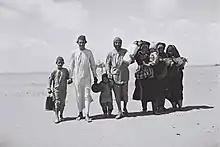عملية عزرا ونحميا
شهدت عملية عزرا ونحميا نقل ما بين 120,000 و130،000 يهودي عراقي جواً إلى فلسطين المحتلة في الفترة بين 1950 و1952 عبر إيران وقبرص.[1][2][3] لم يبقى سوى 2,000 يهودي في العراق اعتباراً من عام 1968.
| هجرة اليهود من الدول العربية 1947–1972 |
|---|
 |
| المواضيع الأساسية |
• معبروت
|
| الخلفيات |
|
| أحداث مفتاحية |
|
| التحكيم |
• خيمينا
|
| الهجرة |
|
| مواضيع مرتبطة |
|
تم تمويل معظم تكاليف العملية البالغة 4 ملايين دولار من قبل لجنة التوزيع اليهودية الأمريكية المشتركة.
تفجيرات بغداد
من أبريل 1950 إلى يونيو 1951، تعرضت أهداف يهودية في بغداد لخمس هجمات. ثم اعتقلت السلطات العراقية ثلاثة يهود بدعوى أنهم من الناشطين الصهاينة، وحكمت على شخصين، هما شالوم صلاح شالوم ويوسف إبراهيم بصري، بالإعدام.[4] وحُكم على شخص ثالث، يهودا تاجار، بالسجن لمدة 10 سنوات.[5] في مايو ويونيو 1951، اكتشفت مخابئ أسلحة يزعم أنها تخص منظمات صهيونية سرية، ويزعم أن الييشوف قد وفرها بعد حادث الفرهود في عام 1941. ويدور نقاش حول ما إذا كانت القنابل قد زرعها الموساد لتشجيع اليهود العراقيين على الهجرة إلى إسرائيل، أو ما إذا كان المتشددون المسلمون قد زرعوها للمساعدة في طرد اليهود. وكانت هذه المسألة موضوع دعاوى وتحقيقات إسرائيلية.[6]
انظر أيضاً
مراجع
- "Operations Ezra & Nechemia: The Aliyah of Iraqi Jews"، مكتبة اليهود الافتراضية، American-Israeli Cooperative Enterprise، مؤرشف من الأصل في 31 أكتوبر 2016، اطلع عليه بتاريخ 27 يونيو 2008.
- World Organization of Jews from Arab Countries (WOJAC): History and Purpose, 17 October 2012, Heskel M. Haddad, "The turning point for the Jews in Iraq was not the Farhood, as it is wrongly assumed." نسخة محفوظة 10 أغسطس 2017 على موقع واي باك مشين.
- Mendes, Phillip (2002)، "The Forgotten Refugees: the causes of the post-1948 Jewish Exodus from Arab Countries - The Case of Iraq"، 14th Jewish Studies Conference, Melbourne، مؤرشف من الأصل في 19 مارس 2017.
- Meir-Glitzenstein 2004، صفحة 202, "For the first few weeks after the enactment of the law, the Zionist activists forbade registration; they were waiting for a clarification of the aliyah routes and a decision by the Israeli government as to its willingness to take in the Jews of Iraq. This ban heightened the tension in the Jewish community. On 8 April 1950, the Zionist leadership (that is, the leaders of Hehalutz and the Haganah, along with the emissaries) convened and discussed the registration issue in view of the pressure from huge numbers of people who wanted to sign up. At the end of the meeting the leadership decided to instruct the people to register and not to wait for instructions from Tel Aviv. A bomb had blown up that day in a Jewish cafe, wounding four people, and the two events were presumably related… The activists' faith in the Zionist ideal and their zeal to implement it, combined with their confidence that Israel would not ignore the aliyah needs of Iraqi Jewry, paved the way to this decision. To inform the Jews of the decision, the leadership issued a proclamation... The fact that the proclamation was written in the name of the State of Israel lent it added force and gave the Jews the impression that the State of Israel and the Israeli government were calling on them to leave Iraq and move to Israel."
- Hirst 2003، صفحة 400
- Fischbach, Michael R. (Fall 2008)، "Claiming Jewish Communal Property in Iraq"، Middle East Report، مؤرشف من الأصل في 15 يوليو 2010، اطلع عليه بتاريخ 05 أبريل 2010.
- بوابة إسرائيل
- بوابة الصراع العربي الإسرائيلي
- بوابة العراق
- بوابة عقد 1950
